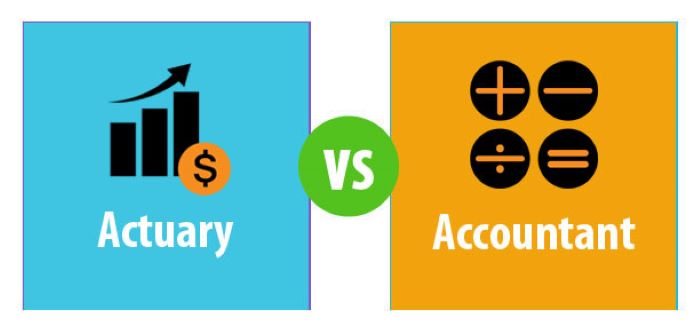Comparing the responsibilities of an actuary and an accountant is important for businesses and individuals looking to understand the roles of these two financial professionals. Actuaries are responsible for analyzing data to assess and manage risk, while accountants are responsible for providing financial information to businesses and individuals. Both roles are essential for the financial health of any organization or individual, and understanding the differences between the two can help ensure the best possible financial outcomes.
Overview of Actuarial and Accounting Responsibilities
Actuarial and accounting responsibilities are two distinct yet related areas of expertise that are essential for the successful operation of any business. An actuary is a specializes in the assessment and management of financial risk. They use mathematical and statistical techniques to analyze and quantify the probability of certain events occurring, such as death, disability, or the occurrence of a natural disaster. An actuary possesses the pivotal duty of assessing the fiscal ramifications associated with such occurrences and crafting tactics to alleviate their consequences..
Accountants, conversely, bear the weight of responsibility when it comes to the meticulous documentation and disclosure of monetary particulars. They meticulously scrutinize and construe financial figures to guarantee precision and adherence to pertinent statutes and standards. Accountants also compile precise financial statements, balance sheets, and assorted records that present an authentic depiction of a corporation’s fiscal well-being.
The amalgamation of actuarial and accounting duties is vital for the triumphant functioning of any enterprise. Actuaries shoulder the responsibility of evaluating and handling financial perils, while accountants take charge of diligently documenting and disclosing financial particulars. Collaboratively, they offer an all-encompassing perspective of a company’s fiscal well-being and aid in guaranteeing its adherence to relevant laws and regulations, thus ensuring smooth operations.
Examining the Differences in Risk Analysis and Financial Reporting
Risk analysis encompasses the intricate steps of recognizing, evaluating, and effectively navigating the perils that intertwine with a business venture. It encompasses a thorough evaluation of the likelihood of encountering detrimental outcomes or harm to a company’s assets, resources, and esteemed standing. This intricate endeavor serves the purpose of identifying potential risks while concurrently formulating the optimal course of action to diminish their impact. Risk analysis is often used to evaluate the financial performance of a company and to make decisions about investments and other financial activities.
Financial reporting, on the other hand, is the process of preparing and presenting financial information about a company. This encompasses the formulation of monetary records, such as the balance sheet, income statement, and statement of cash flows. The act of financial reporting serves the purpose of presenting investors and other concerned parties with an authentic depiction of the corporation’s fiscal well-being. Additionally, it aids in evaluating the company’s accomplishments and in making informed judgments regarding prospective investments and undertakings.
The primary difference between risk analysis and financial reporting is the focus. Risk analysis focuses on potential risks and how to mitigate them, while financial reporting focuses on the financial performance of the company. Risk analysis is used to assess the potential for loss or damage to the company’s assets, resources, and reputation, while financial reporting is used to provide investors and other stakeholders with an accurate picture of the company’s financial health.
Risk analysis and financial reporting play integral roles in the prosperity of a business. They serve as indispensable tools for evaluating a company’s fiscal well-being and making informed judgments regarding its trajectory. Grasping the distinctions between these two facets empowers businesses to arrive at sound decisions, thereby safeguarding their enduring triumph.
Comparing the Use of Statistical Analysis and Mathematical Modeling
Statistical analysis and mathematical modeling are two powerful tools used to analyze data and make predictions. While both techniques are used to draw conclusions from data, they are different in terms of their approach and the types of results they produce.
Statistical analysis is a transformative technique that harnesses numerical data to infer insights regarding a population. It entails the meticulous collection, arrangement, and scrutiny of data to unveil underlying patterns and trends. This analytical approach enables us to forecast future occurrences and uncover interrelationships between variables. In the realm of business, statistical analysis proves indispensable for informed decision-making pertaining to marketing strategies, pricing mechanisms, and product advancement.
Mathematical modeling, on the other hand, harnesses the power of mathematical equations to depict and foresee the behavior of intricate systems. It entails crafting a mathematical representation of a system and subsequently employing it to anticipate its behavior. Mathematical models find application across diverse domains, encompassing engineering, economics, and finance, among others.
The main difference between statistical analysis and mathematical modeling is the type of results they produce. Statistical analysis produces descriptive results, while mathematical modeling produces predictive results. Statistical analysis is used to identify patterns and trends in data, while mathematical modeling is used to make predictions about future events.
Statistical analysis and mathematical modeling are both powerful tools for analyzing data and making predictions. They are used in a variety of fields, from business to engineering, and each has its own strengths and weaknesses. When deciding which technique to use, it is important to consider the type of results you are looking for and the complexity of the data you are analyzing.
Assessing the Different Types of Insurance and Investment Strategies
Evaluating the diverse array of insurance and investment strategies constitutes a pivotal aspect of financial planning. Insurance and investments serve as two fundamental pillars within a comprehensive financial blueprint, necessitating a profound comprehension of the varying types of insurance and investment strategies available. This knowledge empowers individuals to make well-informed choices that align with their financial aspirations.
Insurance acts as a risk management mechanism, offering fiscal safeguards against unexpected losses or damages. A multitude of insurance types exist, spanning across life, health, property, and liability insurance. Life insurance furnishes financial protection to one’s family in the unfortunate event of their demise, while health insurance caters to medical expenses and treatments. Property insurance shields one’s home and tangible assets, and liability insurance covers legal expenses in the event of being held accountable for accidents or injuries.
Investment strategies involve using various financial instruments to generate returns. These strategies can range from low-risk investments such as bonds and mutual funds to more aggressive investments such as stocks and options. Investing in stocks can provide the potential for higher returns, but also carries more risk. Investing in bonds and mutual funds is a more conservative approach, but may provide lower returns.
When assessing different types of insurance and investment strategies, it is important to consider your individual needs and goals. Different types of insurance and investments may be more suitable for different people, depending on their risk tolerance and financial goals. It is also important to consider the costs associated with different types of insurance and investments, as well as the potential returns.
Finally, it is important to understand the different tax implications associated with different types of insurance and investments. Different types of insurance and investments may be subject to different tax rates, so it is important to understand the tax implications before making any decisions.
Assessing the different types of insurance and investment strategies is an important part of financial planning. It is important to understand the different types of insurance and investments available, as well as the associated costs and potential returns. It is also important to consider your individual needs and goals, as well as the tax implications associated with different types of insurance and investments. By taking the time to assess the different types of insurance and investment strategies, you can make informed decisions that will help you reach your financial goals.
Exploring the Role of an Actuary and an Accountant in Corporate Governance
The roles of an actuary and an accountant in corporate governance are essential to the success of any organization. An actuary is a professional who specializes in the assessment and management of risk, while an accountant is responsible for providing financial information and advice to a company. Both professionals are key players in the corporate governance process, and their roles are closely intertwined.
An actuary is responsible for evaluating and managing the financial risks associated with a company’s operations. This includes assessing the potential for losses due to market fluctuations, changes in regulations, and other external factors. An actuary will also analyze the company’s financial data to identify potential risks and develop strategies to mitigate them. In addition, an actuary may be called upon to provide advice on insurance policies, investments, and other financial matters.
An accountant, on the other hand, is responsible for providing financial information and advice to a company. This includes preparing financial statements, monitoring cash flow, and analyzing financial trends. An accountant is also responsible for ensuring that the company’s financial information is accurate and up-to-date. In addition, an accountant may be called upon to provide advice on taxes, budgeting, and other financial matters.
Both an actuary and an accountant play an important role in corporate governance. An actuary is responsible for assessing and managing the financial risks associated with a company’s operations, while an accountant is responsible for providing financial information and advice. Both professionals are essential to the success of any organization, and their roles are closely intertwined.




